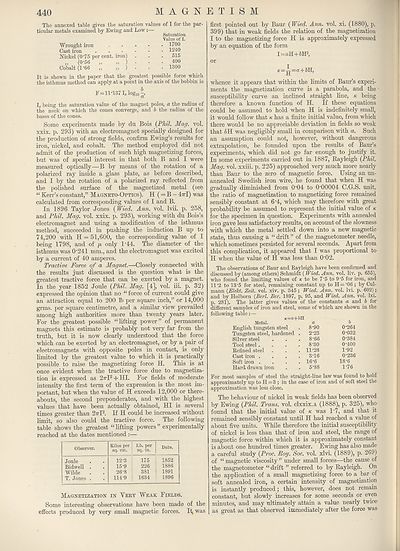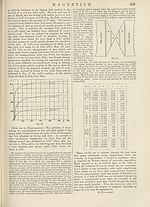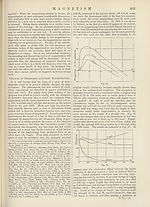New volumes of the Encyclopædia Britannica > Volume 30, K-MOR
(470) Page 440
Download files
Complete book:
Individual page:
Thumbnail gallery: Grid view | List view

440
MAGNETISM
The annexed table gives the saturation values of I for the par¬
ticular metals examined by Ewing and Low :—
Saturation
Value of I.
Wrought iron ..... 1700
Cast iron ...... 1240
Mckel (0’75 per cent, iron) . . . 515
„ (0-56 „ „ ) . . . 400
Cobalt (1-66 „ „ ) • • ■ 1300
It is shown in the paper that the greatest possible force which
the isthmus method can apply at a point in the axis ot the bobbin is
F=11 •137 I* log10
Is being the saturation value of the magnet poles, a the radius of
the neck on which the cones converge, and b the radius of the
bases of the cones.
Some experiments made by du Bois {Phil. Mag. vol.
xxix. p. 293) with an electromagnet specially designed for
the production of strong fields, confirm Ewing’s results for
iron, nickel, and cobalt. The method employed did not
admit of the production of such high magnetizing forces,
but was of special interest in that both B and I were
measured optically—B by means of the rotation of a
polarized ray inside a glass plate, as before described,
and I by the rotation of a polarized ray reflected from
the polished surface of the magnetized metal (see
“ Kerr’s constant,” Magneto-Optics). H (= B - 47tI) was
calculated from corresponding values of I and B.
In 1896 Taylor Jones {Wied. Ann. vol. Ivii. p. 258,
and Phil. Mag. vol. xxix. p. 293), working with du Bois’s
electromagnet and using a modification of the isthmus
method, succeeded in pushing the induction B up to
74,200 with H = 51,600, the corresponding value of I
being 1798, and of g only 1-44. The diameter of the
isthmus was 0'241 mm., and the electromagnet was excited
by a current of 40 amperes.
Tractive Force of a Magnet.—Closely connected with
the results just discussed is the question what is the
greatest tractive force that can be exerted by a magnet.
In the year 1852 Joule {Phil. Mag. [4], vol. iii. p. 32)
expressed the opinion that no “ force of current could give
an attraction equal to 200 ft) per square inch,” or 14,000
grms. per square centimetre, and a similar view prevailed
among high authorities more than twenty years later.
For the greatest possible “lifting power” of permanent
magnets this estimate is probably not very far from the
truth, but it is now clearly understood that the force
which can be exerted by an electromagnet, or by a pair of
electromagnets with opposite poles in contact, is only
limited by the greatest value to which it is practically
possible to raise the magnetizing force H. This is at
once evident when the tractive force due to magnetiza¬
tion is expressed as 27iT2 + IIL For fields of moderate
intensity the first term of the expression is the most im¬
portant, but when the value of H exceeds 12,000 or there¬
abouts, the second preponderates, and with the highest
values that have been actually obtained, HI is several
times greater than 27rl'2. If H could be increased without
limit, so also could the tractive force. The following
table shows the greatest “ lifting powers ” experimentally
reached at the dates mentioned :—
Observer.
Joule
Bidwell
Wilde
T. Jones
Kilos per
sq. cm.
12-3
15-9
26-8
114-9
Lb. per
sq. in.
175
226
381
1634
Date.
1852
1886
1891
1896
Magnetization in Very Weak Fields.
Some interesting observations have been made of the
effects produced by very small magnetic forces. 1^ was
first pointed out by Baur (Wied. A?m. vol. xi. (1880), p.
399) that in weak fields the relation of the magnetization
I to the magnetizing force H is approximately expressed
by an equation of the form
I = aH + &H2,
or
K = ~=a + bH,
whence it appears that within the limits of Baur’s experi¬
ments the magnetization curve is a parabola, and the
susceptibility curve an inclined straight line, k being
therefore a known function of H. If these equations
could be assumed to hold when H is indefinitely small,
it would follow that k has a finite initial value, from which
there would be no appreciable deviation in fields so weak
that was negligibly small in comparison with a. Such
an assumption could not, however, without dangerous
extrapolation, be founded upon the results of Baur’s
experiments, which did not go far enough to justify it.
In some experiments carried out in 1887, Kayleigh (Phil.
Mag. vol. xxiii. p. 225) approached very much more nearly
than Baur to the zero of magnetic force. Using an un¬
annealed Swedish iron wire, he found that when H was
gradually diminished from 0-04 to 0-00004 C.G.S. unit,
the ratio of magnetization to magnetizing force remained
sensibly constant at 6 "4, which may therefore with great
probability be assumed to represent the initial value of k
for the specimen in question. Experiments with annealed
iron gave less satisfactory results, on account of the slowness
with which the metal settled down into a new magnetic
state, thus causing a “ drift ” of the magnetometer needle,
which sometimes persisted for several seconds. Apart from
this complication, it appeared that I was proportional to'
H when the value of H was less than 0"02.
The observations of Baur and Rayleigh have been confirmed and
discussed by (among others) Schmidt ( Wied. Ann. vol. liv. p. 655),
who found the limiting values of k to be 7 "5 to 9 "5 for iron, and
11-2 to 13-5 for steel, remaining constant up to H=-06 ; by Cul-
mann {Elekt. Zeit. vol. xiv. p. 345 ; Wied. Ann. vol. Ivi. p. 602);
and by Holborn {Bcrl. Ber. 1897, p. 95, and Wied. Ann. vol. Ixi.
p. 281). The latter gives values of the constants a and b for
different samples of iron and steel, some of which are shown in the
following table:—
K=a+bH
Metal. a b
English tungsten steel . 8 "90 0"264
Tungsten steel, hardened . 2-23 0"032
Silver steel . . . 8"66 0"384
Tool steel.... 8"30 0"400
Refined steel . . . 11 "28 1"92
Cast iron .... 3"16 0"236
Soft iron .... 16"6 18"6
Hard drawn iron . . 5 "88 1*76
For most samples of steel the straight-line law was found to hold
approximately up to H = 3 ; in the case of iron and of soft steel the
approximation was less close.
The behaviour of nickel in weak fields has been observed
by Ewing (Phil. Trans, vol. clxxix.A (1888), p. 325), who
found that the initial value of k was 1"7, and that it
remained sensibly constant until H had reached a value of
about five units. While therefore the initial susceptibility
of nickel is less than that of iron and steel, the range of
magnetic force within which it is approximately constant
is about one hundred times greater. Ewing has also made
a careful study (Proc. Roy. Soc. vol. xlvi. (1889), p. 269)
of “ magnetic viscosity ” under small forces—the cause of
the magnetometer “ drift ” referred to by Rayleigh. On
the application of a small magnetizing force to a bar. of
soft annealed iron, a certain intensity of magnetization
is instantly produced; this, however, does not remain
constant, but slowly increases for some seconds or even
minutes, and may ultimately attain a value nearly twice
as great as that observed immediately after the force was
MAGNETISM
The annexed table gives the saturation values of I for the par¬
ticular metals examined by Ewing and Low :—
Saturation
Value of I.
Wrought iron ..... 1700
Cast iron ...... 1240
Mckel (0’75 per cent, iron) . . . 515
„ (0-56 „ „ ) . . . 400
Cobalt (1-66 „ „ ) • • ■ 1300
It is shown in the paper that the greatest possible force which
the isthmus method can apply at a point in the axis ot the bobbin is
F=11 •137 I* log10
Is being the saturation value of the magnet poles, a the radius of
the neck on which the cones converge, and b the radius of the
bases of the cones.
Some experiments made by du Bois {Phil. Mag. vol.
xxix. p. 293) with an electromagnet specially designed for
the production of strong fields, confirm Ewing’s results for
iron, nickel, and cobalt. The method employed did not
admit of the production of such high magnetizing forces,
but was of special interest in that both B and I were
measured optically—B by means of the rotation of a
polarized ray inside a glass plate, as before described,
and I by the rotation of a polarized ray reflected from
the polished surface of the magnetized metal (see
“ Kerr’s constant,” Magneto-Optics). H (= B - 47tI) was
calculated from corresponding values of I and B.
In 1896 Taylor Jones {Wied. Ann. vol. Ivii. p. 258,
and Phil. Mag. vol. xxix. p. 293), working with du Bois’s
electromagnet and using a modification of the isthmus
method, succeeded in pushing the induction B up to
74,200 with H = 51,600, the corresponding value of I
being 1798, and of g only 1-44. The diameter of the
isthmus was 0'241 mm., and the electromagnet was excited
by a current of 40 amperes.
Tractive Force of a Magnet.—Closely connected with
the results just discussed is the question what is the
greatest tractive force that can be exerted by a magnet.
In the year 1852 Joule {Phil. Mag. [4], vol. iii. p. 32)
expressed the opinion that no “ force of current could give
an attraction equal to 200 ft) per square inch,” or 14,000
grms. per square centimetre, and a similar view prevailed
among high authorities more than twenty years later.
For the greatest possible “lifting power” of permanent
magnets this estimate is probably not very far from the
truth, but it is now clearly understood that the force
which can be exerted by an electromagnet, or by a pair of
electromagnets with opposite poles in contact, is only
limited by the greatest value to which it is practically
possible to raise the magnetizing force H. This is at
once evident when the tractive force due to magnetiza¬
tion is expressed as 27iT2 + IIL For fields of moderate
intensity the first term of the expression is the most im¬
portant, but when the value of H exceeds 12,000 or there¬
abouts, the second preponderates, and with the highest
values that have been actually obtained, HI is several
times greater than 27rl'2. If H could be increased without
limit, so also could the tractive force. The following
table shows the greatest “ lifting powers ” experimentally
reached at the dates mentioned :—
Observer.
Joule
Bidwell
Wilde
T. Jones
Kilos per
sq. cm.
12-3
15-9
26-8
114-9
Lb. per
sq. in.
175
226
381
1634
Date.
1852
1886
1891
1896
Magnetization in Very Weak Fields.
Some interesting observations have been made of the
effects produced by very small magnetic forces. 1^ was
first pointed out by Baur (Wied. A?m. vol. xi. (1880), p.
399) that in weak fields the relation of the magnetization
I to the magnetizing force H is approximately expressed
by an equation of the form
I = aH + &H2,
or
K = ~=a + bH,
whence it appears that within the limits of Baur’s experi¬
ments the magnetization curve is a parabola, and the
susceptibility curve an inclined straight line, k being
therefore a known function of H. If these equations
could be assumed to hold when H is indefinitely small,
it would follow that k has a finite initial value, from which
there would be no appreciable deviation in fields so weak
that was negligibly small in comparison with a. Such
an assumption could not, however, without dangerous
extrapolation, be founded upon the results of Baur’s
experiments, which did not go far enough to justify it.
In some experiments carried out in 1887, Kayleigh (Phil.
Mag. vol. xxiii. p. 225) approached very much more nearly
than Baur to the zero of magnetic force. Using an un¬
annealed Swedish iron wire, he found that when H was
gradually diminished from 0-04 to 0-00004 C.G.S. unit,
the ratio of magnetization to magnetizing force remained
sensibly constant at 6 "4, which may therefore with great
probability be assumed to represent the initial value of k
for the specimen in question. Experiments with annealed
iron gave less satisfactory results, on account of the slowness
with which the metal settled down into a new magnetic
state, thus causing a “ drift ” of the magnetometer needle,
which sometimes persisted for several seconds. Apart from
this complication, it appeared that I was proportional to'
H when the value of H was less than 0"02.
The observations of Baur and Rayleigh have been confirmed and
discussed by (among others) Schmidt ( Wied. Ann. vol. liv. p. 655),
who found the limiting values of k to be 7 "5 to 9 "5 for iron, and
11-2 to 13-5 for steel, remaining constant up to H=-06 ; by Cul-
mann {Elekt. Zeit. vol. xiv. p. 345 ; Wied. Ann. vol. Ivi. p. 602);
and by Holborn {Bcrl. Ber. 1897, p. 95, and Wied. Ann. vol. Ixi.
p. 281). The latter gives values of the constants a and b for
different samples of iron and steel, some of which are shown in the
following table:—
K=a+bH
Metal. a b
English tungsten steel . 8 "90 0"264
Tungsten steel, hardened . 2-23 0"032
Silver steel . . . 8"66 0"384
Tool steel.... 8"30 0"400
Refined steel . . . 11 "28 1"92
Cast iron .... 3"16 0"236
Soft iron .... 16"6 18"6
Hard drawn iron . . 5 "88 1*76
For most samples of steel the straight-line law was found to hold
approximately up to H = 3 ; in the case of iron and of soft steel the
approximation was less close.
The behaviour of nickel in weak fields has been observed
by Ewing (Phil. Trans, vol. clxxix.A (1888), p. 325), who
found that the initial value of k was 1"7, and that it
remained sensibly constant until H had reached a value of
about five units. While therefore the initial susceptibility
of nickel is less than that of iron and steel, the range of
magnetic force within which it is approximately constant
is about one hundred times greater. Ewing has also made
a careful study (Proc. Roy. Soc. vol. xlvi. (1889), p. 269)
of “ magnetic viscosity ” under small forces—the cause of
the magnetometer “ drift ” referred to by Rayleigh. On
the application of a small magnetizing force to a bar. of
soft annealed iron, a certain intensity of magnetization
is instantly produced; this, however, does not remain
constant, but slowly increases for some seconds or even
minutes, and may ultimately attain a value nearly twice
as great as that observed immediately after the force was
Set display mode to:
![]() Universal Viewer |
Universal Viewer | ![]() Mirador |
Large image | Transcription
Mirador |
Large image | Transcription
Images and transcriptions on this page, including medium image downloads, may be used under the Creative Commons Attribution 4.0 International Licence unless otherwise stated. ![]()
| Encyclopaedia Britannica > New volumes of the Encyclopædia Britannica > Volume 30, K-MOR > (470) Page 440 |
|---|
| Permanent URL | https://digital.nls.uk/193573611 |
|---|
| Attribution and copyright: |
|
|---|---|
| Shelfmark | EB.18 |
|---|---|
| Description | Ten editions of 'Encyclopaedia Britannica', issued from 1768-1903, in 231 volumes. Originally issued in 100 weekly parts (3 volumes) between 1768 and 1771 by publishers: Colin Macfarquhar and Andrew Bell (Edinburgh); editor: William Smellie: engraver: Andrew Bell. Expanded editions in the 19th century featured more volumes and contributions from leading experts in their fields. Managed and published in Edinburgh up to the 9th edition (25 volumes, from 1875-1889); the 10th edition (1902-1903) re-issued the 9th edition, with 11 supplementary volumes. |
|---|---|
| Additional NLS resources: |
|

